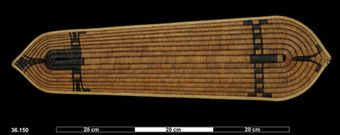Connect with Horniman Museum and Gardens
Contact this content partner to get more information about this item.
shield (weapons: accessories)
- Description:
- Oval War Shield, Eastern Cape, probably Wamira People, Milne Bay Province, Papua New Guinea Little is known about these remarkable carved shields, other than that they were formerly made in the Eastern Cape area of Papua New Guinea. As a result, they are likely to have been made by carvers from the Wamira people who occupy the easternmost tip of the New Guinea mainland. From the form of the bamboo scaffold supporting the shield’s grip, we can deduce that they were made to be held upright. The shield has a sharp curve from left to right, and would have provided an excellent surface for deflecting the blows of blunt weapons, such as the sword-clubs used throughout the Massim. The wood is soft and light: these shields would have primarily offered defence from arrows by absorbing their force as they penetrated into the body of the shield. The engraving and painting style of the shield’s decoration is very strong, and although it has close resonances with the curvilinear decoration of the island groups off the peninsula, it is nevertheless quite unique. Wood, bamboo. Late 19th Century. Provenance unknown. Wooden shield of ovate form and concavo-convex section. The section of the shield thickens from 1 to 2 cm across the back of the shield in a broad band. To this band are lashed stout cane ropes across the face of the shield which are fixed together by a lattice work of split bamboo across the back of the shield. A loop of Coconut fibre cordage serves as a handle. The face is decorated with shallow incised relief carving and painted in black red and white. The design involves a broad white horizontal band which divides a black oval; outside this there are tapering red scroll work elements above and below, and above is a distinctive circular element against a black background.
- Format:
- image
- Collections:
- Horniman Museum and Gardens
- Content partner:
- Horniman Museum and Gardens
- Availability:
- Not specified
-
Copyright status: All rights reservedFind out more about what you are able to do with this itemThis item is all rights reserved, with means you'll have to get permission from Horniman Museum and Gardens before using it. For more information, please see our use and reuse page.More informationHorniman Museum and Gardens has this to say about the rights status of this item:
http://rightsstatements.org/vocab/InC/1.0/
What can I do with this item?Non-infringing useNZ copyright law does not prevent every use of a copyright work, and this item may be hosted by an international institute or organisation. You should consider what you can and cannot do with a copyright work.No sharingYou may not copy and/or share this item with others without further permission. This includes posting it on your blog, using it in a presentation, or any other public use.No modifyingYou are not allowed to adapt or remix this item into any other works.No commercial useYou may not use this item commercially.
Welcome and warm Pasifik greetings
The information on this site has been gathered from our content partners.
The names, terms, and labels that we present on the site may contain images or voices of deceased persons and may also reflect the bias, norms, and perspective of the period of time in which they were created. We accept that these may not be appropriate today.
If you have any concerns or questions about an item, please contact us.


